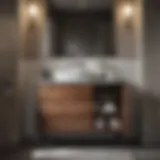The Charm of Retro Bath Faucets: A Deep Dive
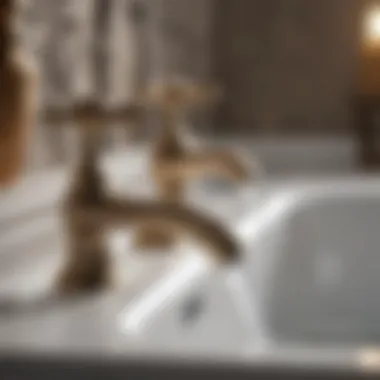
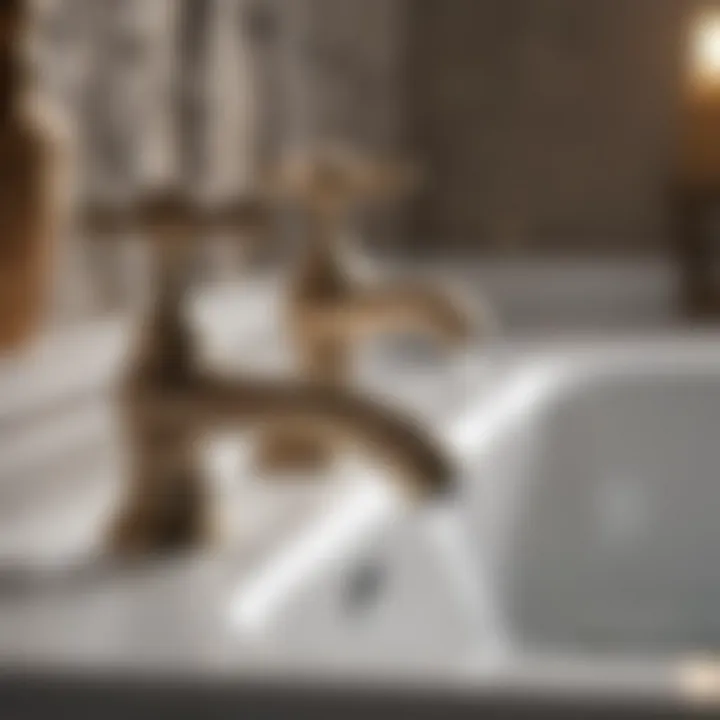
Intro
In recent years, there’s been a noticeable return to styles that evoke the past, and retro bath faucets have become a staple in many contemporary bathrooms. They draw on the charm and craftsmanship of earlier eras, providing not only a functional element but also a focal point in bathroom design. The resurgence of retro fixtures taps into a collective yearning for nostalgia while meeting modern efficiency standards. This article explores the allure of retro bath faucets, guiding homeowners through every essential aspect, from the materials needed to installation and maintenance.
Materials:
To kick off your journey into the retro world of bath faucets, having the right materials is crucial. Below is a list of what you’ll need:
- Retro Bath Faucet (Choose a preferred style; check specifications for sizes)
- Plumber's Tape (Teflon Tape) - 1 roll, 1/2 inch width
- Adjustable Wrench - for pipe fittings
- Pipe Cutter - suitable for copper or PVC pipes
- Silicone Sealant - one tube, clear or white (for sealing connections)
- Screwdriver Set - flathead and Phillips
- Drill - with appropriate bits for tile or drywall
- Level - for ensuring proper alignment of the faucet
- Safety Goggles - to protect your eyes when cutting
- Measuring Tape - for accurately gauging spaces
DIY Steps:
Step 1: Planning the Space
Before jumping into the actual installation, it’s key to map out your bathroom layout. Take careful measurements of where the faucet will go, ensuring it aligns well with your sink and complements existing elements. Don’t forget to consider the overall style of the faucet — from sleek chrome finishes to antique brass.
Step 2: Preparing the Area
If you are replacing an existing faucet, turn off the water supply. Clear the workspace to prevent any accidents. It's also wise to have towels or a bucket handy to catch any drips.
Step 3: Remove the Old Faucet
Using your adjustable wrench, disconnect the water supply lines connected to the existing faucet. Then remove the retaining nuts holding the faucet in place. Carefully lift the faucet out, clean the area, and check for any issues in the sink or countertop that may need addressing before you proceed.
Step 4: Installing the New Faucet
Place the new retro faucet in position. Ensure all gaskets and washers are properly placed to prevent leaks. Secure the faucet according to the manufacturer's instructions. Reconnect the water supply lines, taking care to wrap plumber's tape around the threads to enhance sealing.
Step 5: Sealing and Testing
Apply a bead of silicone sealant around the base to prevent water seepage. Wait for the sealant to cure according to the package instructions. Then, turn the water supply back on and check for leaks by turning on the faucet and observing all connections.
Technical Aspects:
Once you have all your materials ready, it’s time to understand some key technical aspects that will elevate your DIY project:
- Tools Needed: A solid set of tools, including wrenches, a drill, and screwdrivers, are essential.
- Timing: Expect the entire project to take anywhere from 1 to 3 hours, depending on your familiarity with plumbing tasks.
- Critical Techniques:
- Always double-check your measurements; measure twice, cut once.
- Use a level to ensure everything is straight and aligned, avoiding frustrating adjustments later.
DIY Project Process:
Sequential Steps:
- Start with Preparation: Assess existing plumbing and ensure compatibility with new faucet.
- Careful Installation: Follow each step thoroughly to ensure proper attachment and sealing.
- Final Checks: After the installation, allow the silicone to cure, then retest the fixture.
Troubleshooting Tips:
If you encounter common issues during installation:
- Leaking Faucets: Check all connections; tightening or correcting the alignment often fixes this.
- Water Pressure Drops: Inspect for blockages or check the aerator as it might require cleaning.
Remember, patience and attention to detail are key in any DIY project. You're not just installing a faucet; you're enhancing your home with a dash of nostalgia and style.
By following these guidelines, homeowners can seamlessly incorporate retro bath faucets into their spaces, celebrating the perfect blend of vintage elegance and modernity.
Understanding Retro Aesthetics
Retro aesthetics in bathroom design invite homeowners to connect with a rich tapestry of history. When one thinks of retro bath faucets, they often evoke a sense of nostalgia, transporting users back to simpler times filled with iconic designs. Recognizing the importance of retro aesthetics allows for a better appreciation of the individual elements that define this charming allure. In this article, we take a closer look at how these elements contribute to the vintage vibe while offering practical benefits in contemporary settings.
Historical Background
The fascination with retro bath fixtures stems from a time when craftsmanship reigned supreme. Take, for instance, the early 20th century's artistry infused into fixtures. In these days, manufacturers paid meticulous attention to detail, showcasing intricate designs and high-quality materials. Notably, the late 1920s saw the rise of Art Deco, characterized by its bold geometric shapes and rich colors.
Collectors and design enthusiasts often seek out these pieces not only for their timeless appeal but also for the stories they carry. These faucets often come adorned with unique handles and elaborate patterns which today may appear extraordinary but were commonplace back then. The history they embody adds layers to their charm, making them more than mere tools but rather conversation starters that link past and present.
Evolution of Bathroom Fixtures
Understanding the evolution of bathroom fixtures helps us see how retro elements remain relevant today. Over the decades, bathrooms have transformed from utilitarian spaces to tranquil retreats. In the mid-20th century, when home design started taking on more character, the introduction of colorful ceramic tiles and standalone bathtubs paved the way for design experimentation.
The shift also brought about various developments in faucet technology. In the past, you would twist a single handle to get the job done, but with modern advancements, we now have options like thermostatic controls which enhance user experience while reducing water waste. Yet, many retro designs have been infused with such technology, ensuring the aesthetic charm remains intact while offering the conveniences of today.
"Fusing old-world charm with modern functionality is what makes retro bath faucets appealing to homeowners looking to create a signature style in their spaces."
As bathroom design continues to evolve, the resurgence of retro fixtures has highlighted a yearning for the past, particularly for mid-century modern and Victorian aesthetics. Local design shows and expos have featured unique lines of retro faucets that echo the styles from yesteryears, leading consumers to seek them out to capture the essence of their favorite era.
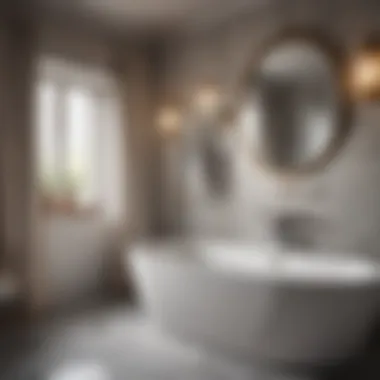
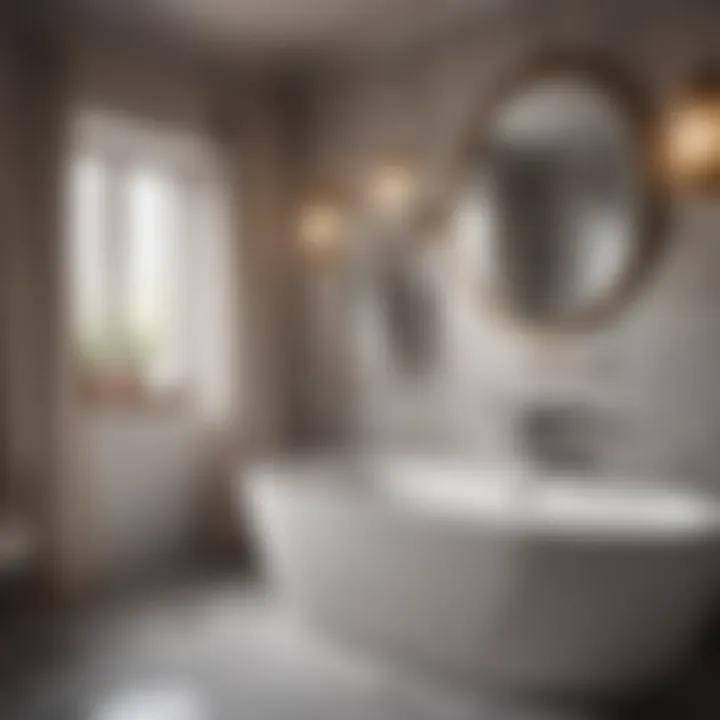
In summary, understanding retro aesthetics encompasses both historic significance and the evolution of design concepts. Choosing a retro bath faucet goes beyond style—it connects families with the craftsmanship of past artisans and promotes a cohesive, meaningful narrative in modern bathrooms.
Characteristics of Retro Bath Faucets
Understanding the characteristics of retro bath faucets is essential for those looking to enhance their bathroom’s aesthetic and functional appeal. It's not just about style; these elements combine to offer a unique user experience that stands apart from contemporary designs. Homeowners appreciate the nostalgia these fixtures evoke while also gaining practical benefits that align with modern needs.
Design Elements
Material Choices
The selection of materials for retro bath faucets plays a vital role in both the look and durability of the fixtures. Many of these faucets are crafted from high-quality brass, which has stood the test of time. Brass not only exudes luxury but also offers excellent corrosion resistance. This is crucial in a wet environment like a bathroom, where other materials might not hold up as well over time.
A unique feature of brass is that it develops a rich patina as it ages, giving each faucet a distinct character. This aging process can be seen as an advantage; however, some homeowners may prefer the polished shine of newer fixtures. Stainless steel has also emerged as a popular option, providing a modern twist to retro designs while maintaining the necessary strength and water-tightness.
Color Schemes
Color schemes in retro faucets can be a delightful mixture of both subtle and bold shades, reflecting the eras they are inspired by. For instance, pastel colors were all the rage in mid-century homes, making fixtures in soft pinks or mint greens ideal for evoking that vintage charm.
The choice of color greatly enhances the atmosphere of a bathroom. Additionally, it can serve as a means of integration into a broader decorative theme. Prospective buyers should acknowledge that while vibrant colors can serve as statement pieces, they may require more upkeep to keep looking fresh over time. Neutral tones, in contrast, can assure timeless elegance, yet they might not offer the same character as bolder options.
Finishes
Finishes on retro faucets significantly influence their visual appeal and maintenance requirements. Chrome finishes remain a classic choice, reflecting light and adding a touch of shine that can make a bathroom feel brighter and more spacious.
However, satin or brushed finishes are gaining traction for those desiring a softer, less reflective look. Such finishes can hide fingerprints and water spots better than chrome, making them popular in households with children or heavy usage. One should keep in mind that specific finishes may require particular cleaning methods or products to maintain their beauty.
Functional Features
Water Flow Mechanisms
The water flow mechanisms in retro bath faucets have evolved with technology while still embracing the designs of the past. Traditional compression valves are what many older plumbing systems use, but newer ceramic disc valves are increasingly popular due to their durability and ease of use. They offer smoother operation compared to older models and usually have a longer lifespan.
The advantages are clear; ceramic disc valves minimize leaks and provide a steady water flow. However, homeowners must consider the compatibility of these mechanisms with their existing plumbing, potentially incurring extra costs for adaptation.
Temperature Control
Temperature control remains a significant aspect of any faucet, and retro designs have made strides to include efficient options. Many modern retro faucets come with single-lever controls, allowing homeowners to adjust water temperature quickly without fuss.
While the single lever provides ease and speed, older models with separate hot and cold handles can add a touch of authenticity. One potential drawback, however, may be the slight learning curve for users not accustomed to these older configurations.
Eco-Friendly Options
As environmental concerns rise, eco-friendly options in retro faucets have become more prevalent. Low-flow aerators are a hallmark of these designs, helping reduce water usage without compromising pressure.
The key characteristic of eco-friendly faucets is that they cater to modern sustainability goals while retaining the nostalgic ambiance of retro style. An obvious advantage is the potential for lower water bills. But one must note that some eco-friendly fixtures might require more frequent maintenance to keep the aerators clean and functioning properly.
Choosing the right retro faucet means balancing aesthetics, functionality, and sustainability, ensuring your bathroom reflects both personal style and modern expectations.
Popular Retro Design Styles
Exploring popular retro design styles offers a window into how past eras influence contemporary aesthetics. Exhibiting charm and character, retro bath faucets serve as the focal point in bathroom designs that aim to blend nostalgia with modern functionality. Each style, whether stemming from the lavish Art Deco period, the functional yet stylish Mid-Century Modern movement, or the vibrant resurgence reflected in Vintage Revival, contributes distinct traits that resonate with homeowners and designers alike. Understanding these styles allows individuals to make informed choices that satisfy both personal taste and practical needs.
Art Deco Inspirations
Art Deco is synonymous with glamour and opulence. Flourishing in the early 20th century, its striking geometric patterns and elaborate detailing can be mirrored in today’s bathroom styles. Retro faucets inspired by this movement often feature:
- Bold geometric shapes that bring visual interest.
- High-shine finishes, like chrome or brass, which evoke a sense of luxury.
- Interesting textures that play with light and add depth.
Having Art Deco-inspired faucets can transform an ordinary bathroom into a haven of elegance. The sophistication of this style speaks to those who have an appreciation for the artistry of design, making it a fitting addition for anyone looking to create a memorable atmosphere. Additionally, these faucets can serve as distinctive conversation starters among guests, illustrating the blend of inspiration from past and present.
"Art Deco design captivates hearts, reviving the elegance of a bygone era while seamlessly integrating into modern decor."
Mid-Century Modern Influence
The Mid-Century Modern design emerged in the 1940s and continued to inspire through the 60s. Characterized by clean lines, functionality, and a focus on simplicity, this style resonates strongly in bathroom fixtures today. Key features of Mid-Century Modern retro faucets include:
- Streamlined forms that eliminate unnecessary ornamentation, highlighting practicality.
- Warm wood accents or colorful ceramic bases, evoking a warm, inviting feel.
- Innovative materials, focusing on durable and sustainable options that prioritize longevity.
For homeowners aiming to cultivate a peaceful and uncluttered bathroom environment, Mid-Century Modern faucets can offer practical solutions without sacrificing style. Their ability to mix easily with various decorative elements means they can fit seamlessly into both minimalistic and eclectic spaces, offering versatility that is hard to beat.
Vintage Revival
Vintage Revival holds a unique charm through its direct callbacks to the delightful quirks of past decades. This style is all about embracing character and individualism in bathroom design. Faucets that fit within this trend often exhibit:
- Colorful enamel finishes or nostalgic pastel tones that can brighten any bathroom.
- Unique shapes and designs, such as curved spouts or handles reminiscent of vintage charm.
- Retro branding and logos, that evoke feelings of nostalgia and remind users of simpler times.
By incorporating Vintage Revival faucets, homeowners can create a playful and inviting atmosphere that encourages relaxation and leisure. The emphasis on color and character can revitalize a dull space, making every visit to the bathroom a delightful experience. This style has grown more popular among those who enjoy expressing their personality through their home decor choices, adding a personal touch that resonates deeply.
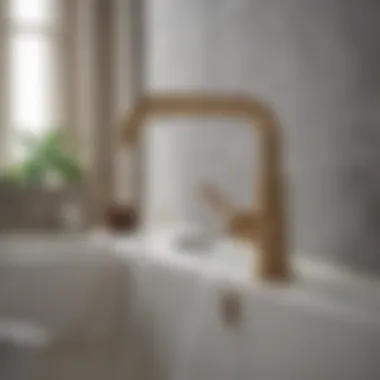
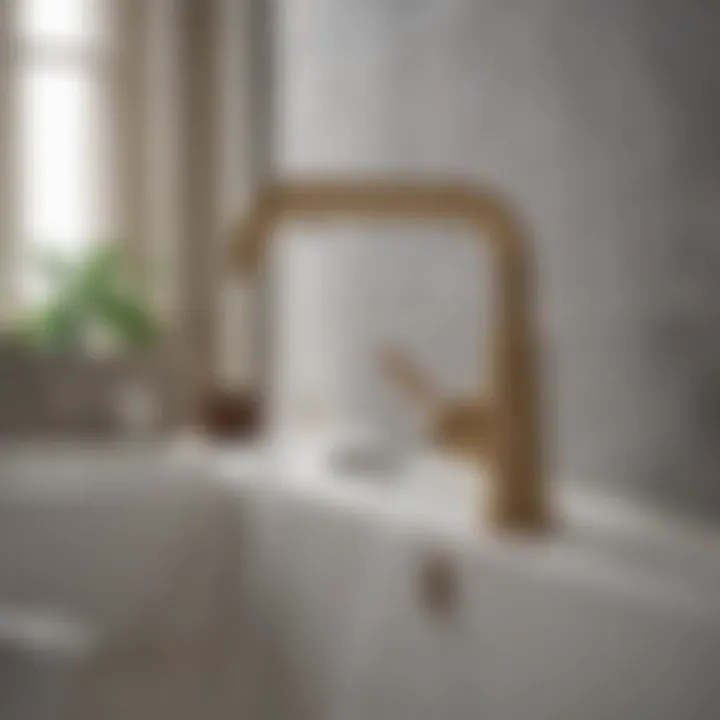
The Role of Retro Faucets in Modern Bathroom Design
When one thinks about crafting a bathroom that harmonizes old-world charm with contemporary style, the role of retro faucets becomes quite pivotal. These fixtures not only serve as functional tools but also enhance the visual narrative of a space. By integrating retro elements, homeowners can carve out a unique personality that resonates with warmth and nostalgia, making their bathrooms far from ordinary.
Blending Old and New
In the art of design, the task of melding the vintage with the modern can bear a sense of excitement and, yes, challenge. Retro faucets often come in designs that hark back to bygone eras, like the intricate art deco styles or the sleek lines of mid-century modern pieces. Such elements create a bridge across time, showing how what's past can coexist with what's current.
Take, for example, a house fitted with modern wooden elements and sleek glass finishes. A vintage faucet—perhaps a brass piece with ornamental detailing—can act as a stunning focal point amidst the minimalist decor. Picture it sitting above a black granite countertop; the juxtaposition of materials beautifully illustrates how retro can spice up modern designs. Thoughtful placement can yield interesting conversations amongst guests, as they admire the distinct aesthetics of an era long past while enjoying today's luxuries.
It’s essential to keep a balance in mind. Too much focus on retro aspects could make a space feel cluttered or disconnected. Homeowners should choose faucets that deliberately echo the era they cherish yet maintain a practical vibe that fits their modern needs.
Creating a Cohesive Bathroom Theme
To achieve a harmonious bathroom, one should focus on crafting a cohesive theme that intertwines all elements—including color schemes, materials, and styles. Retro faucets can lead the charge here, as they naturally draw attention and can unite disparate elements.
To create that cohesive look, consider the faucet's finish—whether polished chrome, brushed nickel, or a rustic bronze. Here’s how to pull it all together:
- Color Palette: Select a color scheme that showcases your faucet while harmonizing with other fixtures. For example, warm earthy tones matched with a brass faucet can elevate the cozy vibe.
- Complementary Fixtures: Pair the faucet with vintage-style lighting fixtures or mirrors that share similar finishes. These choices can create an echo throughout the space.
- Textiles and Accessories: Don’t overlook towels, mats, and even shower curtains. Selecting retro-inspired patterns can enhance the look while staying in tune with today’s sensibilities.
"A well-established theme is like a well-tuned orchestra, where each element plays its part in creating a beautiful symphony."
In the end, the blend of various components should speak to your personal style, turning the bathroom into a sanctuary that exudes both comfort and sophistication. By embracing the duality of retro faucets in the modern setting, one can achieve a delightful balance that feels both welcoming and timeless.
Installation Considerations for Retro Bath Faucets
When it comes to choosing the perfect retro bath faucet, installation considerations can't be overlooked. The right faucet not only adds charm to the bathroom, but it also needs to function smoothly and fit properly within your space. Understanding the details of installation will help you avoid headaches down the line.
Plumbing Requirements
Before you start dreaming of soaking in a beautifully adorned bathroom, it’s critical to get a handle on the plumbing requirements. Not every retro faucet will fit comfortably into your existing plumbing setup—a fact that can leave some homeowners in a right pickle. Here are the key points to keep in mind:
- Pipe Compatibility: Ensure that the faucet you pick is compatible with your current pipe system. Most commonly, plumbing systems use either 1/2-inch or 3/4-inch connections.
- Water Pressure: Retro faucets are often designed to operate under certain water pressure levels. Check your home’s water pressure to ensure that it meets the manufacturer's recommendations. No one wants a faucet that drips more than it flows!
- Hot and Cold Lines: Make certain that your hot and cold water lines are easily accessible and configured properly for the installation. Mismanagement here could lead to frustration come installation time, or worse, a misfire when trying to mix that perfect bath temperature.
Integrating a retro faucet into your bathroom isn’t just a cosmetic change; it can also be a practical upgrade if the plumbing is addressed properly. It's advisable to have any potential plumbing changes mapped out before you lay your hands on that shiny new faucet.
DIY vs. Professional Installation
The decision between tackling the installation yourself or hiring a professional can be a tough nut to crack. It often boils down to skill level and comfort with plumbing tasks. Let’s take a closer look at both options:
DIY Installation
Going the DIY route can certainly save you some cash, and it’s a satisfying way to engage with your home project. However, a little knowledge goes a long way:
- Knowledge Base: Familiarize yourself with the installation manual. A good faucet will come with step-by-step guidelines. Don’t skip any details, as overlooking minor points could lead to complications.
- Tools Needed: Make sure you have all necessary tools at your disposal. Generally, you’ll need adjustable wrenches, screwdrivers, and possibly a basin wrench.
- Time and Patience: Allocate sufficient time for the job. Rushing through it can lead to mistakes that might cost more than hiring a pro in the first place.
Professional Installation
If your plumbing knowledge is as shaky as a leaf in the wind, hiring a professional can provide peace of mind. Here are some benefits:
- Expertise: A qualified plumber will not only ensure that everything is installed right the first time, but they can also spot underlying plumbing issues that you might miss.
- Time-Efficient: Professionals tend to work faster than the average homeowner. While your friend might pop over during weekends, a hired expert likely has a full toolbox to get it done in a jiffy.
- Insurance: With professional installation, there’s often a warranty or guarantee on the work done. That means in the case of any issues, you won’t be left holding the bag.
Ultimately, whether you decide to roll up your sleeves or call in the cavalry comes down to your confidence level and the intricacies of your existing plumbing. Whatever path you choose, understanding the installation considerations will ensure that your retro faucet shines both in functionality and aesthetic.
Maintenance and Care for Retro Faucets
Taking care of retro bath faucets is key to preserving their charm and functionality. These fixtures do not just serve practical purposes; they are also significant design elements that can elevate the entire aesthetic of a bathroom. Retro faucets, often crafted from high-quality materials and traditional designs, require a level of maintenance tailored to their unique characteristics. Proper care ensures they remain both visually appealing and operationally sound for years to come.
Understanding common maintenance tasks can prevent future headaches and costly repairs. Over time, mineral deposits, corrosion, and grit can build up, potentially affecting performance. Regular upkeep helps to uphold the faucet's functionality and prolongs the lifespan of these delightful fixtures.
Cleaning Tips
Keeping retro faucets clean is simple but essential. Here are some effective tips to ensure they remain spotless:
- Gentle Cleaners: Use mild, non-abrasive cleaners. Cleaners containing vinegar or baking soda work wonders without damaging the finish. Abrasive materials can scratch the surface and wear it down, leading to tarnishing.
- Soft Cloths: Always opt for soft, lint-free cloths. Microfiber cloths are an excellent choice for wiping down surfaces without leaving scratches.
- Avoid Harsh Chemicals: Stay away from bleach or ammonia-based products as they may cause serious damage to the finishes of retro faucets.
- Regular Rinsing: After applying cleaners, make sure to rinse the faucets thoroughly to remove any residue. This prevents buildup and preserves their sheen.
- Drying After Use: Wipe the faucets dry after use to prevent water spots and mineral deposits from forming. This simple step can keep them looking brand new.
"Regular cleaning not only enhances the appearance of retro faucets but also prevents issues from developing in the long run."
Common Issues and Solutions
While retro faucets are usually durable, they can encounter some common problems. Here’s a rundown of typical issues and their straightforward solutions:
- Leaking Faucets: A leaky faucet can be bothersome and wasteful. Often, this issue can stem from worn-out washers or O-rings. Replacing these components usually resolves the problem relatively easily.
- Low Water Pressure: If water pressure seems lackluster, minerals might be clogging the aerator. Simply unscrew the aerator, soak it in vinegar, then scrub away any deposits before reinstalling.
- Rust or Corrosion: Older faucets, particularly those made from lesser materials, may develop rust. Sanding the affected areas gently can help, followed by applying a suitable sealant or polish to protect the exposed metal.
- Discoloration: Over time, finishes can fade due to exposure. A paste of baking soda and water can help restore some luster. For deeper restoration, consider consulting a professional.
Proactive maintenance can enhance both the aesthetic appeal and functionality of retro faucets, ensuring they remain timeless pieces in your bathroom design.
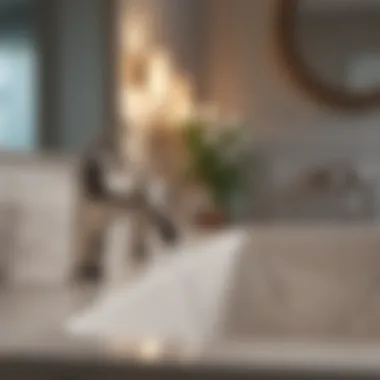
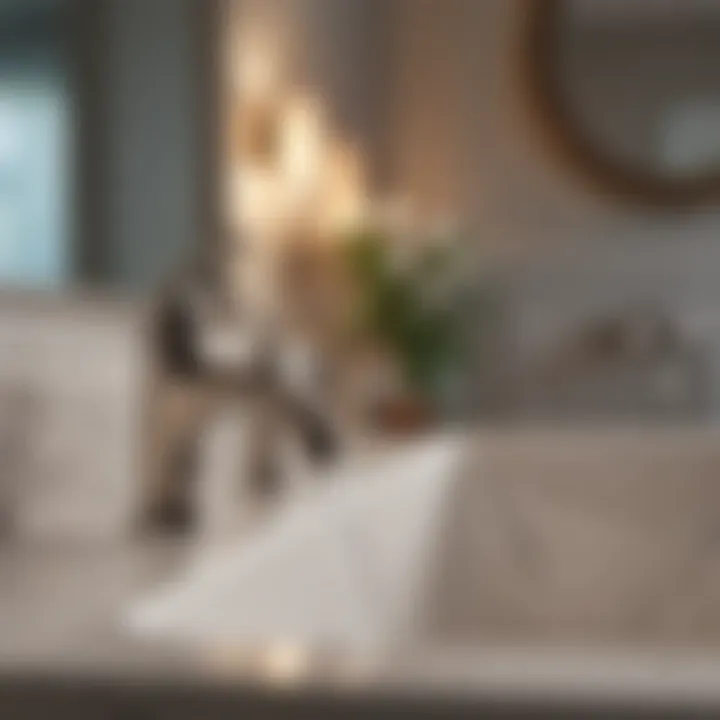
Environmental Considerations
In today's world, the choices we make in our homes extend beyond aesthetics and functionality. Environmental considerations play a significant role in ensuring that the products we select align with broader sustainability goals. When it comes to retro bath faucets, understanding the eco-friendly aspects can greatly influence buying decisions for housewives and homeowners alike, making this topic an essential part of the conversation.
Retro bath faucets not only bring nostalgia to your bathroom design but also offer modern solutions to environmental challenges. The unique blend of design and function in these fixtures can foster both beauty and responsibility in your home. As consumers become increasingly conscious of their carbon footprint, integrating environmentally friendly products like retro faucets not only reflects personal taste but also aligns with a more sustainable way of living.
"Choosing retro bath faucets is not merely a nod to nostalgia; it is a step towards embracing eco-conscious choices in our modern lives."
Water Conservation Technologies
More than just spouts for releasing water, retro bath faucets can incorporate advanced water conservation technologies. These features are essential for minimizing water wastage while retaining high functionality and aesthetic appeal. Here are some technologies that you might find:
- Aerators: These devices mix air into the water stream to reduce water flow without sacrificing pressure. By using aerators, homeowners can save water while enjoying a satisfying bathing experience.
- Low-Flow Systems: Designed to limit water flow, these systems significantly reduce usage, often achieving a decrease to under two gallons per minute, all while maintaining performance.
- Smart Water Sensors: Some retro designs include modern sensors that detect when the tap is in use. These can help homeowners track their water usage and make adjustments as needed, promoting responsible consumption.
By selecting retro faucets equipped with these water-saving features, homeowners not only enhance the style of their bathrooms but also contribute positively to environmental conservation efforts.
Sustainable Material Choices
When considering the purchase of retro bath faucets, the materials used in their construction is a critical aspect to think about. The sustainability of these materials can significantly affect their environmental footprint over their entire life cycle. Here are some choices that stand out:
- Recycled Metals: Many contemporary manufacturers utilize recycled brass or chrome, reducing the strain on natural resources and minimizing carbon emissions.
- Eco-Friendly Coatings: Look for faucets that have finishes made from environmentally safe materials. These clear coatings can protect the surface without harmful chemicals, while also offering durability against wear and tear.
- Natural Stone and Wood: If opting for vintage-inspired designs that feature stone or wood, make sure these materials are sourced sustainably. Reclaimed wood, for instance, can provide stunning design accents while promoting environmental health.
By focusing on sustainable materials, homeowners not only contribute to preserving the planet but also invest in quality designs that stand the test of time.
Selecting the Right Retro Bath Faucet
Choosing the right retro bath faucet is a pivotal step in bringing character and charm to your bathroom. It’s more than just a fixture; it’s an element that defines the space, speaking volumes about your taste and style. When well-selected, these faucets can not only provide function but also serve as a conversation starter. Their vintage aesthetics evoke a sense of nostalgia, while their careful integration can elevate the overall decor.
Assessing Personal Style
Understanding your personal style is crucial in this selection process. Retro faucets come in various themes—ranging from the elegant curves of Art Deco to the minimalist lines of Mid-Century Modern. Think about the overall vibe you want to convey. Consider these aspects:
- Color Palette: Will your faucet complement existing colors? Shades like nickel or oil-rubbed bronze often work harmoniously with various tiles and fixtures.
- Material Choices: Each material lends a different effect. Chrome offers a sleek, polished look, whereas brass can bring warmth and richness to your space.
- Finishes: The finish can significantly alter the faucet's aesthetic. Matte and brushed finishes are popular for those favoring a more subdued elegance, while shiny options boast a bold statement.
By taking inventory of your tastes and preferences, you enhance the likelihood of choosing a faucet that not only fits well but also resonates deeply with your personal expression.
Budget Considerations
Budgeting plays a fundamental role in your faucet selection. Retro faucets can range from affordable to extravagant based on brand, material, and design. Here are a few tips to keep in mind:
- Set a Realistic Budget: Line items such as installation and maintenance should be part of your budget planning.
- Research Brands: Some brands offer high-quality but affordable options, while others provide luxury products. Aligning your expectations with your budget can save a lot of headaches down the line.
- Look for Sales: Promotions and seasonal sales can be a treasure trove for discerning buyers. Keep your eyes peeled for deals from reputable vendors.
Taking these factors into account can help you strike a balance between aesthetics and cost—essential in ensuring satisfaction with your purchase, both now and in the long run.
Vendor Recommendations
Finding the right vendor for your retro bath faucet can be just as important as selecting the faucet itself. Not all vendors carry the same stock, and their expertise can greatly influence your purchasing decision. There are a few paths you could consider:
- Online Retailers: Websites like Wayfair and Overstock often have extensive selections, allowing for easier comparisons.
- Local Hardware Stores: These can provide tailored advice, and you get the benefit of seeing the product in person.
- Specialty Bathroom Outlets: Stores that focus on bathroom fixtures may carry unique brands not available at general retailers, helping you find that perfect statement piece.
"Choosing the right vendor can make all the difference in the journey to achieving your desired bathroom aesthetic."
In sum, investing time in assessing personal style, putting together a spending plan, and selecting the appropriate vendor can lead to a gratifying purchasing experience. This careful approach ensures that your retro faucet stands out as a stunning focal point in your bathroom, balancing both function and aesthetic appeal.
Integrating Retro Faucets into Various Bathroom Configurations
In the world of bathroom design, retro faucets have established themselves as conversation starters, bridging the gap between nostalgic aesthetics and modern functionality. When considering renovations or design updates, integrating these faucets into various bathroom configurations becomes paramount. It's not just about picking a faucet that looks good; it’s about how it anchors the overall design of the space and complements its specific style while ensuring practical usability.
Specific Elements to Consider:
- Style Cohesion: Ensuring the retro faucet aligns with the bathroom's theme adds to the visual appeal.
- Space Optimization: Retro faucets can be elegant solutions even in cramped quarters, enhancing rather than hindering space.
- Functional Benefits: Retro designs can bring modern features, making the faucet not only beautiful but also practical.
Small Spaces
In small bathrooms, every decision matters. Retro faucets can prove to be a wise choice due to their ability to deliver charm without overwhelming the space. Choosing the right color, finish, and size is essential. A petite, sleek faucet with an antique copper finish might add just the right touch without crowding the sink area.
To effectively integrate retro faucets into smaller configurations:
- Choose a Compact Design: Opt for faucets that have a low profile and don’t protrude too much, allowing for better accessibility and reducing visual clutter.
- Use Lighter Finishes: Metallics like chrome or brushed nickel can make the space feel airier while retaining that vintage essence.
- Coordinate with Other Features: If your space has retro tiles or fixtures, select faucets that share those similarities to create a more unified design.
By focusing on these factors, even the smallest of bathrooms can ooze style, turning what could be an ordinary space into a personal retreat.
Luxury Suites
In luxury bathrooms, the integration of retro faucets can serve as a stunning focal point. Here, grandeur and style coalesce to create a sanctuary. Large, ornate faucets styled after vintage designs can be paired with high-end materials for a dramatic effect.
For a luxurious integration, consider the following recommendations:
- Go Bold with Design: Large, elegantly crafted faucets make a strong statement, especially when using sophisticated finishes such as polished brass or oil-rubbed bronze.
- Employ Contrast: Pairing a classic, vintage-style faucet with contemporary bathroom elements or minimalist decor can create a striking visual contrast.
- Focus on Artistry: Look for faucets with intricate details or artistic embellishments that elevate the overall look while highlighting the history and craftsmanship of retro designs.
By ensuring that these luxe elements are thoughtfully integrated, luxury bathrooms can capture both the essence of retro appeal and the elegance expected in high-end spaces.
"A well-chosen faucet can turn a simple sink into the star of the show, enhancing both functionality and aesthetic value."


